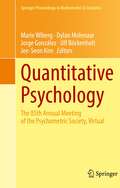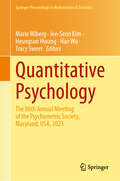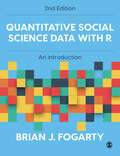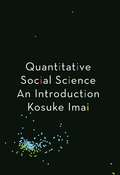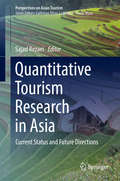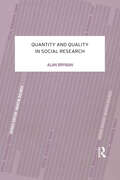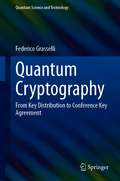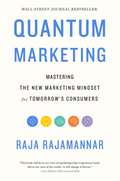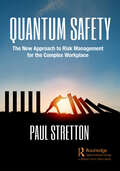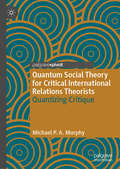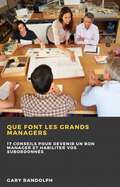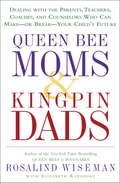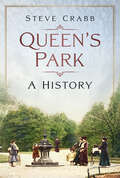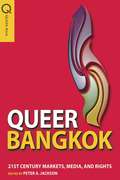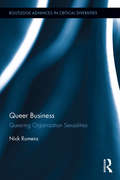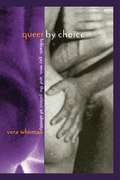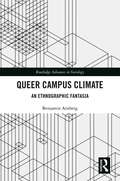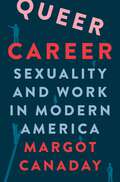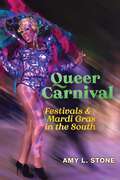- Table View
- List View
Quantitative Psychology: The 85th Annual Meeting of the Psychometric Society, Virtual (Springer Proceedings in Mathematics & Statistics #353)
by Marie Wiberg Jorge González Dylan Molenaar Ulf Böckenholt Jee-Seon KimThis proceedings volume highlights the latest research and developments in psychometrics and statistics. It represents selected and peer-reviewed presentations given at the 85th Annual International Meeting of the Psychometric Society (IMPS), held virtually on July 13-17, 2020. The IMPS is one of the largest international meetings on quantitative measurement in education, psychology and the social sciences. It draws approximately 500 participants from around the world, featuring paper and poster presentations, symposiums, workshops, keynotes, and invited presentations. Leading experts and promising young researchers have written the included chapters. The chapters address a wide variety of topics including but not limited to item response theory, adaptive testing, Bayesian estimation, propensity scores, and cognitive diagnostic models. This volume is the 9th in a series of recent works to cover research presented at the IMPS.
Quantitative Psychology: The 88th Annual Meeting of the Psychometric Society, Maryland, USA, 2023 (Springer Proceedings in Mathematics & Statistics #452)
by Marie Wiberg Jee-Seon KimThis book includes presentations given at the 88th annual meeting of the Psychometric Society, held in Maryland, USA on July 24–28, 2023. The proceeding covers a diverse set of psychometric topics. The topics include, but are not limited to item response theory, cognitive diagnostic models, Bayesian estimation, validity and reliability issues, and several applications within different fields. The authors are from all over the world, they work in different psychometrics areas, as well as having diverse professional and academic experiences.
Quantitative Social Science Data with R: An Introduction
by Brian J FogartyRelevant, engaging, and packed with student-focused learning features, this book provides the basic step-by-step introduction to quantitative research and data every student needs. Gradually introducing applied statistics and the language and functionality of R and R Studio software, it uses examples from across the social sciences to show students how to apply abstract statistical and methodological principles to their own work. Maintaining a student-friendly pace, it goes beyond a normal introductory statistics book and shows students where data originates and how to: - Understand and use quantitative data to answer questions - Approach surrounding ethical issues - Collect quantitative data - Manage, write about, and share the data effectively Supported by incredible digital resources with online tutorials, videos, datasets, and multiple choice questions, this book gives students not only the tools they need to understand statistics, quantitative data, and R software, but also the chance to practice and apply what they have learned.
Quantitative Social Science Data with R: An Introduction
by Brian J FogartyRelevant, engaging, and packed with student-focused learning features, this book provides the basic step-by-step introduction to quantitative research and data every student needs. Gradually introducing applied statistics and the language and functionality of R and R Studio software, it uses examples from across the social sciences to show students how to apply abstract statistical and methodological principles to their own work. Maintaining a student-friendly pace, it goes beyond a normal introductory statistics book and shows students where data originates and how to: - Understand and use quantitative data to answer questions - Approach surrounding ethical issues - Collect quantitative data - Manage, write about, and share the data effectively Supported by incredible digital resources with online tutorials, videos, datasets, and multiple choice questions, this book gives students not only the tools they need to understand statistics, quantitative data, and R software, but also the chance to practice and apply what they have learned.
Quantitative Social Science: An Introduction
by Kosuke ImaiAn introductory textbook on data analysis and statistics written especially for students in the social sciences and allied fieldsQuantitative analysis is an increasingly essential skill for social science research, yet students in the social sciences and related areas typically receive little training in it—or if they do, they usually end up in statistics classes that offer few insights into their field. This textbook is a practical introduction to data analysis and statistics written especially for undergraduates and beginning graduate students in the social sciences and allied fields, such as economics, sociology, public policy, and data science.Quantitative Social Science engages directly with empirical analysis, showing students how to analyze data using the R programming language and to interpret the results—it encourages hands-on learning, not paper-and-pencil statistics. More than forty data sets taken directly from leading quantitative social science research illustrate how data analysis can be used to answer important questions about society and human behavior.Proven in the classroom, this one-of-a-kind textbook features numerous additional data analysis exercises and interactive R programming exercises, and also comes with supplementary teaching materials for instructors.Written especially for students in the social sciences and allied fields, including economics, sociology, public policy, and data scienceProvides hands-on instruction using R programming, not paper-and-pencil statisticsIncludes more than forty data sets from actual research for students to test their skills onCovers data analysis concepts such as causality, measurement, and prediction, as well as probability and statistical toolsFeatures a wealth of supplementary exercises, including additional data analysis exercises and interactive programming exercisesOffers a solid foundation for further studyComes with additional course materials online, including notes, sample code, exercises and problem sets with solutions, and lecture slidesLooking for a more accessible introduction? Consider Data Analysis for Social Science by Elena Llaudet and Kosuke Imai, which teaches from scratch and step-by-step the fundamentals of survey research, predictive models, and causal inference. It covers descriptive statistics, the difference-in-means estimator, simple linear regression, and multiple linear regression.
Quantitative Social Science: An Introduction in Stata
by Kosuke Imai Lori D. BougherThe Stata edition of the groundbreaking textbook on data analysis and statistics for the social sciences and allied fieldsQuantitative analysis is an increasingly essential skill for social science research, yet students in the social sciences and related areas typically receive little training in it—or if they do, they usually end up in statistics classes that offer few insights into their field. This textbook is a practical introduction to data analysis and statistics written especially for undergraduates and beginning graduate students in the social sciences and allied fields, such as business, economics, education, political science, psychology, sociology, public policy, and data science.Quantitative Social Science engages directly with empirical analysis, showing students how to analyze data using the Stata statistical software and interpret the results—it emphasizes hands-on learning, not paper-and-pencil statistics. More than fifty data sets taken directly from leading quantitative social science research illustrate how data analysis can be used to answer important questions about society and human behavior.Proven in classrooms around the world, this one-of-a-kind textbook features numerous additional data analysis exercises, and also comes with supplementary teaching materials for instructors.Written especially for students in the social sciences and allied fields, including business, economics, education, psychology, political science, sociology, public policy, and data scienceProvides hands-on instruction using Stata, not paper-and-pencil statisticsIncludes more than fifty data sets from actual research for students to test their skills onCovers data analysis concepts such as causality, measurement, and prediction, as well as probability and statistical toolsFeatures a wealth of supplementary exercises, including additional data analysis exercises and interactive programming exercisesOffers a solid foundation for further studyComes with additional course materials online, including notes, sample code, exercises and problem sets with solutions, and lecture slides
Quantitative Tourism Research in Asia: Current Status And Future Directions (Perspectives on Asian Tourism)
by Sajad RezaeiThe purpose of this book is twofold. First, this book is an attempt to map the state of quantitative research in Asian tourism and hospitality context and provide a detailed description of the design, implementation, application, and challenges of quantitative methods in tourism in Asia. Second, this book aims to contribute to the tourism literature by discussing the past, current and future quantitative data analysis methods.The book offers new insights into well-established research techniques such as regression analysis, but goes beyond first generation data analysis techniques to introduce methods seldom – if ever – used in tourism and hospitality research. In addition to investigating existing and novel research techniques, the book suggests areas for future studies. In order to achieve its objectives the analysis is split into three main sections: understanding the tourism industry in Asia; the current status of quantitative data analysis; and future directions for Asian tourism research.
Quantitive Analysis Of Biospec
by Per Lundahl; Andreas Lundqvist; Eva GreijerFirst published in 2004, this book collects several up-to-date methods for quantitative analysis of biospecific interactions, a field that has a long history that perhaps can be said to have begun with the classical paper of G. Scatchard in 1949 (The attractions of proteins for small molecules and ions, but which has advanced impressively during the last few years. A precise spatial arrangement of just a few hydrogen bonds can confer a remarkably specific reversible association between two molecules. A web of weak interactions governs biospecific recognition in general. The binding equilibria in living cells tune and coordinate a multitude of functions. The thermodynamic properties of such interactions are often studied by binding experiments in simplified and essentially ideal systems. However, similar types of studies may elucidate the biologically relevant dynamic steady-state conditions in living cells and organisms, allowing for the very wide range of interactant concentrations and the interplay between the many reactions and interactions. The development in biosciences will continue with in-depth studies of macromolecules and membranes. More detailed knowledge will allow analyses of delicate balances between substances and events in the complex systems involved in life processes. Methods to study biospecific affinities are thus highly important tools for understanding mechanisms and effects of molecular binding events in vivo and in vitro, e.g., in biochemical, biomedical and pharmaceutical research, and for biotechnological research and production.
Quantity and Quality in Social Research
by Alan BrymanFirst published in 1988. Routledge is an imprint of Taylor & Francis, an informa company.
Quantum Cryptography: From Key Distribution to Conference Key Agreement (Quantum Science and Technology)
by Federico GrasselliRising concerns about the security of our data have made quantum cryptography a very active research field in recent years. Quantum cryptographic protocols promise everlasting security by exploiting distinctive quantum properties of nature. The most extensively implemented protocol is quantum key distribution (QKD), which enables secure communication between two users. The aim of this book is to introduce the reader to state-of-the-art QKD and illustrate its recent multi-user generalization: quantum conference key agreement. With its pedagogical approach that doesn’t disdain going into details, the book enables the reader to join in cutting-edge research on quantum cryptography.
Quantum Marketing: Mastering the New Marketing Mindset for Tomorrow's Consumers
by Raja RajamannarRaja Rajamannar, Chief Marketing Officer of Mastercard, shares breakthrough, frontier strategies to navigate the challenges marketers face to thrive in a modern business world that is changing with unprecedented speed and disruption.As technology has continually evolved in the last several decades, marketing has had to change with it, evolving through four significant stages that build on the strategies and tools of the previous era. What happens next in the fifth stage, or Fifth Paradigm, will not be an evolution, but a revolution. Almost everything about how marketing is done today, including the very notion of a brand itself, will require a complete re-imagination.As Chief Marketing Officer of Mastercard—one of the world&’s most recognizable and decorated brands—Raja Rajamannar shares the forward-thinking ways all businesses must rethink their entire marketing landscape to remain relevant and be successful.Readers will:Understand the evolution of marketing and how to be at the forefront of future change.Get clarity on the right marketing strategies and tactics to pursue amidst an ever-evolving industry.Achieve breakthroughs in innovative thinking in order to compete in modern business.Gain perspective from top marketers across industries. Quantum Marketing is for all business people who seek to understand how rapidly marketing is evolving, what some of the smartest people in the discipline are doing to get ready for this dramatic shift, and what the new world will look like for companies, consumers, and society at large as the race to develop revolutionary marketing strategies reaches a whole new level.
Quantum Safety: The New Approach to Risk Management for the Complex Workplace
by Paul StrettonThis book is the most comprehensive review of health and safety in half a century. Most organisational approaches to health and safety are based on the methodology developed during the 1970s, and despite the workplace changing beyond recognition since that time, these approaches have remained untouched. Quantum Safety will develop a new understanding fit for the modern workplace. Quantum Safety is an approach that is part of the "new view" debate. There have been a number of other new approaches to health and safety in recent years, and while they all have merit and improve understanding to help create the optimal, safe working environment, they have failed to significantly create the change desired. These approaches are often flawed at the philosophical or conceptual level or propose a solution without a pathway to implement the principles in safety-critical environments. Quantum Safety: The New Approach to Risk Management for the Complex Workplace is founded on a wholesale critical analysis of the conceptual foundations of health and safety before translating the revised principles into a tangible methodology. Central to the development of Quantum Safety is the application of Complexity Science. The traditional approach to health and safety is considered to be Newtonian – it uses linear models and deterministic analysis. Quantum Safety, due to the full consideration of Complexity Science, introduces multidimensional models and develops analysis based on probabilities. Crucially, this does not render Newtonian methodologies as worthless – in the same manner that Newtonian physics was able to take mankind to the moon, but required the quantum understanding within computers to make it possible – Quantum Safety provides the mechanisms to complete organisations’ safety-based journeys. The new mechanisms are fully developed for the reader at both macro and micro levels. How an organisation measures safety and what it values are reset and re-examined. How we investigate adverse events and the consequential actions taken with employees to develop a true Just Culture within a high-performing culture are also completely revised. Essentially, Quantum Safety creates a pathway for understanding health and safety in the complex modern world. To achieve that, new models are introduced to replace the dated, simple tools and a new language is developed to communicate this powerful approach. It will help propel an organisation from considering safety within a concept of industrialised failure avoidance to valuing safety as an integrated aspect of high performance.
Quantum Safety: The New Approach to Risk Management for the Complex Workplace
by Paul StrettonThis book is the most comprehensive review of health and safety in half a century. Most organisational approaches to health and safety are based on the methodology developed during the 1970s, and despite the workplace changing beyond recognition since that time, these approaches have remained untouched. Quantum Safety will develop a new understanding fit for the modern workplace. Quantum Safety is an approach that is part of the "new view" debate. There have been a number of other new approaches to health and safety in recent years, and while they all have merit and improve understanding to help create the optimal, safe working environment, they have failed to significantly create the change desired. These approaches are often flawed at the philosophical or conceptual level or propose a solution without a pathway to implement the principles in safety-critical environments. Quantum Safety: The New Approach to Risk Management for the Complex Workplace is founded on a wholesale critical analysis of the conceptual foundations of health and safety before translating the revised principles into a tangible methodology. Central to the development of Quantum Safety is the application of Complexity Science. The traditional approach to health and safety is considered to be Newtonian – it uses linear models and deterministic analysis. Quantum Safety, due to the full consideration of Complexity Science, introduces multidimensional models and develops analysis based on probabilities. Crucially, this does not render Newtonian methodologies as worthless – in the same manner that Newtonian physics was able to take mankind to the moon, but required the quantum understanding within computers to make it possible – Quantum Safety provides the mechanisms to complete organisations’ safety-based journeys. The new mechanisms are fully developed for the reader at both macro and micro levels. How an organisation measures safety and what it values are reset and re-examined. How we investigate adverse events and the consequential actions taken with employees to develop a true Just Culture within a high-performing culture are also completely revised. Essentially, Quantum Safety creates a pathway for understanding health and safety in the complex modern world. To achieve that, new models are introduced to replace the dated, simple tools and a new language is developed to communicate this powerful approach. It will help propel an organisation from considering safety within a concept of industrialised failure avoidance to valuing safety as an integrated aspect of high performance.
Quantum Social Science
by Emmanuel Haven Andrei KhrennikovWritten by world experts in the foundations of quantum mechanics and its applications to social science, this book shows how elementary quantum mechanical principles can be applied to decision-making paradoxes in psychology and used in modelling information in finance and economics. The book starts with a thorough overview of some of the salient differences between classical, statistical and quantum mechanics. It presents arguments on why quantum mechanics can be applied outside of physics and defines quantum social science. The issue of the existence of quantum probabilistic effects in psychology, economics and finance is addressed and basic questions and answers are provided. Aimed at researchers in economics and psychology, as well as physics, basic mathematical preliminaries and elementary concepts from quantum mechanics are defined in a self-contained way.
Quantum Social Theory for Critical International Relations Theorists: Quantizing Critique (Palgrave Studies in International Relations)
by Michael P. MurphyThis book examines the crossroads of quantum and critical approaches to International Relations and argues that these approaches share a common project of uncovering complexity and uncertainty. The “quantum turn” in International Relations theory has produced a number of interesting insights into the complex ways in which our assumptions about the physics of the world around us can limit our understanding of social life. While critique is possible within a Newtonian social science, core assumptions of separability and determinism of classical physics impose limits on what is imaginable. The author argues that by adopting a quantum imaginary, social theory can move beyond its Newtonian limits, and explore two methods for quantizing conceptual models—translation and application. This book is the first introductory book to quantum social theory ideas specifically intended for an audience of critical International Relations.
Quartiersentwicklung in ländlichen Kommunen: Möglichkeiten und Grenzen organisierter Dorfgemeinschaft (Edition Centaurus - Perspektiven Sozialer Arbeit in Theorie und Praxis)
by René GründerDas Konzept der Quartiersentwicklung entstand in einem großstädtischen Kontext. Mit der Annäherung der Lebenswelten von Menschen in städtischen und ländlichen Kommunen, wird diese sozialräumliche Strategie aber auch für kleinere Städte und Gemeinden interessant. Was bei der Übertragung von Quartiersentwicklungsansätzen auf die Besonderheiten des ländlichen Raumes zu bedenken ist und welche Chancen sowie Herausforderungen dies für die Gestaltung zukunftsfähiger Dorfgemeinschaften bedeutet, wird in diesem Buch auf Grundlage von Theorie und Forschungsergebnissen praxisbezogen dargestellt.
Que Font Les Grands Managers: 17 Conseils pour devenir un bon manager et habiliter vos subordonnés
by Gary RandolphOn dit qu'un employé heureux est un employé productif et qu'un bon manager peut rendre un employé heureux, ce qui fera de lui un employé productif. Si vous souhaitez maximiser le rendement de votre organisation, vous devez avoir certaines qualités de leadership en vous. L'une des responsabilités d'un manager compétent est d'aider votre équipe à rester productive et bien organisée. Cet ebook est un guide détaillé pour améliorer les compétences managériales qui augmenteront le rendement de votre organisation. Cet ebook vous apprendra : - Comment former votre équipe. - Comment motiver votre équipe. - Comment organiser votre équipe. - Amélioration des compétences de communication. - Conseils pour devenir un bon manager. - Comment se racheter. - Problèmes courants auxquels les managers sont confrontés. - Comment résoudre les problèmes courants. --> Faites défiler vers le haut de la page et cliquez sur Ajouter au panier pour acheter instantanément Clause de non-responsabilité: Cet auteur et/ou le(s) titulaire(s) des droits ne font aucune réclamation, promesse ou garantie en ce qui concerne l'exactitude, la complétude ou la pertinence du contenu de ce livre, et décline expressément toute responsabilité pour les erreurs et omissions dans le contenu. Ce produit est à titre de référence uniquement. Veuillez consulter un professionnel avant d'agir ou suivre l'un des contenus trouvés dedans.
Queen Bee Moms & Kingpin Dads
by Rosalind WisemanIn Queen Bee Moms & Kingpin Dads, Rosalind Wiseman gives us the tools to handle difficult situations involving teachers and other parents with grace. Reassuring, funny, and unfailingly honest, Wiseman reveals: * Why PTA meetings and Back-to-School nights tap into parents' deepest insecurities * How to recognize the archetypal moms and dads- from Caveman Dad to Hovercraft Mom * How and when to step in and step out of your child's conflicts with other children, parents, teachers, or coaches * How to interpret the code phrases other parents use to avoid (or provoke) confrontation * Why too many well-meaning dads sit on the sidelines, and how vital it is that they step up to the plate * What to do and say when the playing field becomes an arena for people to bully and dominate other kids and adults * How to have respectful yet honest conversations with other parents about sex and drugs when your values are in conflict * How the way you handle parties, risky behavior, and academic performance affects your child * How unspoken assumptions about race, religion, and other hot-button subjects sabotage parents' ability to work together Queen Bee Moms & Kingpin Dads is filled with the kind of true stories that made Wiseman's New York Times best-selling book Queen Bees & Wannabes impossible to put down. There are tales of hardworking parents with whom any of us can identify, along with tales of outrageously bad parents- the kind we all have to reckon with. For instance, what do you do when parents donate a large sum of money to a school and their child is promptly transferred into the honors program- while your son with better grades doesn't make the cut? What about the mother who helps her daughter compose poison-pen e-mails to yours? And what do you say to the parent-coach who screams at your child when the team is losing? Wiseman offers practical advice on avoiding the most common parenting "land mines" and useful scripts to help you navigate difficult but necessary conversations. Queen Bee Moms & Kingpin Dads is essential reading for parents today. It offers us the tools to become wiser, more relaxed parents- and the inspiration to speak out, act according to our values, show humility, and set the kind of example that will make a real difference in our children's lives.
Queen's Park: A History
by Steve CrabbDismissed by planners in the 1950s as fit only for demolition and replacement with tower blocks, Queen’s Park is now one of London’s most vibrant and thriving communities: culturally diverse, with a vigorous campaigning spirit as well as being home to world-renowned actors, writers and musicians.This is its storyFrom ancient Britain to the current day, defiant suffragettes to neo-Nazi arsonists, and First World War fighter aces to the Windrush generation, Queen’s Park: A History is a meticulously researched book that brings the past to life. Uncover mysteries, scandals, horrors and heroes – and discover how a London community ebbed and flowed to take the shape it has today.
Queer Bangkok: 21st Century Markets, Media, and Rights
by Peter A. JacksonThe Thai capital Bangkok is the unrivalled centre of the country's gay, lesbian and transgender communities. These communities are among the largest in Southeast Asia, and indeed in the world, and have a diversity, social presence and historical depth that set them apart from the queer cultures of many neighbouring societies. The first years of the 21st Century have marked a significant transition moment for all of Thailand's LGBT cultures, with a multidimensional expansion in the geographical extent, media presence, economic importance, political impact, social standing, and cultural relevance of Thai queer communities. This book analyzes the roles of the market and media - especially cinema and the Internet - in these transformations, and considers the ambiguous consequences that the growing commodification and mediatisation of queer lives have had for LGBT rights in Thailand. A key finding is that in the early 21st Century processes of global queering are leading to a growing Asianisation of Bangkok's queer cultures. This book traces Bangkok's emergence as a central focus of an expanding regional network linking gay, lesbian and transgender communities in Hong Kong, Singapore, Taiwan, Indonesia, the Philippines and other rapidly developing East and Southeast Asian societies. Peter A. Jacksonis associate professor in the School of Culture, History and Language at Australian National University. "The myriad faces of Thai gender/sexuality culture have been an attraction for both pleasure-seekers and researchers/scholars/activists. Exploring the rapidly changing LGBT cultures and Thai queer identities, the essays collected here provide insightful analyses of historical continuities as well as developing variations within the highly complex erotic/economic texture of Thai society. A must-read for anyone in the booming field of gender/sexuality studies. " -Josephine Ho, Chair Professor, Center for the Study of Sexualities, National Central University, Taiwan
Queer Business: Queering Organization Sexualities (Routledge Advances in Critical Diversities)
by Nick RumensIn this modern day and age, it is surprising that managerialist perspectives, practices and ideas are colonising the study of sexualities in organisation. A timely intervention into the contemporary vitality of queer theories, Queer Business is an innovative book length exploration of how queer theory has been used in management and organisation studies, with the aim of broadening and deepening queer scholarship in this discipline. Through both scholarly and original empirical research, Rumens also seeks to demonstrate how queer theory has been mobilised in MOS and how it might be advanced in a field where it has yet to become exhausted and clichéd. In particular, this volume shows how scholars can use queer theory concepts to explore how lesbian, gay, bisexual and transgender sexualities and genders are understood and experienced in the workplace. Challenging notions of LGBT+ inclusivity in the workplace through concepts such as queer liberalism and homonormativity, Queer Business will appeal to scholars, undergraduate and postgraduate students and postdoctoral researchers interested in fields such as management and organisation studies, queer studies, gender studies, sexuality studies, organisational theory and cultural studies.
Queer By Choice: Lesbians, Gay Men, and The Politics of Identity
by Vera WhismanQueer by Choice enters the controversial debate of sexual identity by examining choice in gay men and lesbian sexual identity. Drawing on interviews with a sample of 72 people, Whisman analyzes if, and to what extent, choice played a role in determining identity. Contributing factors such as race, class, religion, and educational level are considered. The results of the study are stimulating and often surprising, and contribute to the escalating debates over sexual identity as lesbians and gays continue to soldier for rights and representation.
Queer Campus Climate: An Ethnographic Fantasia (Routledge Advances in Sociology)
by Benjamin ArnbergQueer Campus Climate: An Ethnographic Fantasia is a visceral and provocative account of the lives of ten queer college men living in the Deep South. The book serves many goals. It is an emancipatory research document told in the raucous, fiery voices of these queer men whose narratives are presented free from the sanitizing impulses of traditional scholarship. It is a manifesto on postqualitative paradigms applied to a queer subject. It is a public history of the life and times of queers subjects living under an alt-right political assault. And it is an analysis of how a hostile campus climate impacts psychosocial development of marginalized students. Blurring the line between literature and research, Queer Campus Climate: An Ethnographic Fantasia contains a cast of characters (including a bear, a twink, and three drag queens) who dish on sex, gender performance, mental wellness, relationships, harassment, addiction, professional development, and politics. Their stories are told against a musical backdrop that includes selections from Puccini to Frank Ocean, which provides a multisensory experience unlike anything else in sociological research.
Queer Career: Sexuality and Work in Modern America
by Margot CanadayA masterful history of the queer workforce in AmericaWorkplaces have traditionally been viewed as &“straight spaces&” in which queer people passed. As a result, historians have directed limited attention to the experiences of queer people on the job. Queer Career rectifies this, offering an expansive historical look at sexual minorities in the modern American workforce. Arguing that queer workers were more visible than hidden and, against the backdrop of state aggression, vulnerable to employer exploitation, Margot Canaday positions employment and fear of job loss as central to gay life in postwar America.Rather than finding that many midcentury employers tried to root out gay employees, Canaday sees an early version of &“don&’t ask / don&’t tell&”: in all kinds of work, as long as queer workers were discreet, they were valued for the lower wages they could be paid, their contingency, their perceived lack of familial ties, and the ease with which they could be pulled in and pushed out of the labor market. Across the socioeconomic spectrum, they were harbingers of post-Fordist employment regimes we now associate with precarity. While progress was not linear, by century&’s end some gay workers rejected their former discretion, and some employers eventually offered them protection unattained through law. Pushed by activists at the corporate grass roots, business emerged at the forefront of employment rights for sexual minorities. It did so, at least in part, in response to the way that queer workers aligned with, and even prefigured, the labor system of late capitalism.Queer Career shows how queer history helps us understand the recent history of capitalism and labor and rewrites our understanding of the queer past.
Queer Carnival: Festivals and Mardi Gras in the South
by Amy L. StoneThe importance of citywide festivals like Mardi Gras and Fiesta for the LGBTQ communityFestivals like Mardi Gras and Fiesta have come to be annual events in which entire cities participate, and LGBTQ people are a visible part of these celebrations. In other words, the party is on, the party is queer, and everyone is invited. In Queer Carnival, Amy Stone takes us inside these colorful, eye-catching, and often raucous events, highlighting their importance to queer life in America’s urban South and Southwest. Drawing on five years of research, and over a hundred days at LGBTQ events in cities such as San Antonio, Santa Fe, Baton Rouge, and Mobile, Stone gives readers a front-row seat to festivals, carnivals, and Mardi Gras celebrations, vividly bringing these queer cultural spaces and the people that create and participate in them to life. Stone shows how these events serve a larger fundamental purpose, helping LGBTQ people to cultivate a sense of belonging in cities that may be otherwise hostile. Queer Carnival provides an important new perspective on queer life in the South and Southwest, showing us the ways that LGBTQ communities not only survive, but thrive, even in the most unexpected places.
